Spiders are endlessly fascinating, but one of the little-known yet amazing facts about them is that some spiders eat fish as part of their diet.
In this article, we’ll consider how spiders can eat fish that are several times their size, the hunting techniques that make this possible, and some of the most interesting species of fish-eating spiders.
Do Spiders Really Eat Fish?
Surprisingly, spiders from at least eight different arachnid families have been observed by scientists eating fish. Fish-eating spiders tend to be far larger than others, enabling them to seize, bite and drag prey up to five times larger than themselves.
The largest fish ever formally recorded as being caught by a fishing spider was a goldfish in a garden pond. Two scientists reported that the fish measured 9cm and weighed approximately 10g.
As opportunistic hunters, these spiders don’t confine themselves to eating fish, but also trap insects, tadpoles, and any other passing invertebrates.
How Can Spiders Catch Fish?
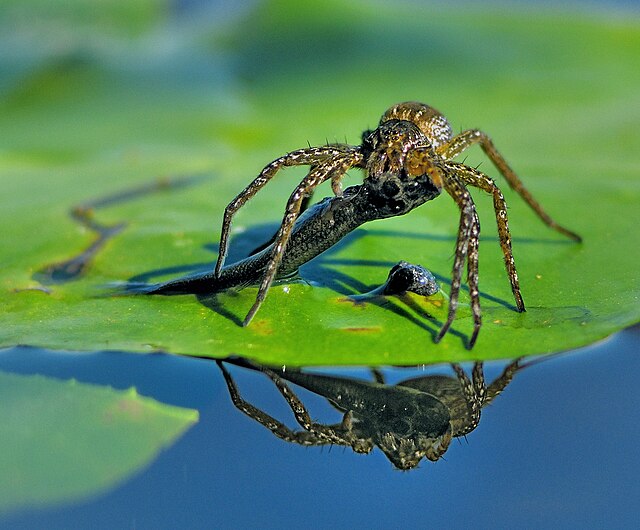
A spider is eating a fish
Fish-eating spiders are typically found, well camouflaged, among rocks, gravel, or flora that border shallow streams, ponds, and swamps, or other bodies of water. However certain intertidal varieties such as the Desis marina live in seawater.
They can typically be spotted sitting close to the water’s edge, with their long front legs outstretched and partially submerged. However, they’re not relaxing – they are waiting patiently until they sense prey is within reach.
When a fish or tadpole comes to the surface of the water to breathe, it makes concentric ripples in the water. The spider senses the vibration through the hairs on its legs and locates its prey by pinpointing the center of the circle.
Research has proved that they can also distinguish the vibrations of a potential meal from those caused by a falling twig or leaf.
Once it knows that prey is within reach, the water-repellent hairs on the fish-eating spider’s legs allow it to race across the surface of the water and seize the unfortunate victim in its powerful jaws. The vast majority of kills are achieved by a bite to the base of the head.
Certain spider species tether themselves to the shore with a silk line, to help them slow down and avoid flying past their target.
In addition to sensing vibrations with unerring accuracy, and allowing them to walk on water, the hairs on their body have further use.
These hairs also trap bubbles of air, meaning the spider is buoyant and able to dive under the water, swimming short distances in pursuit of its prey.
Because of the importance of their hairs, fishing spiders put a lot of effort into keeping themselves clean.
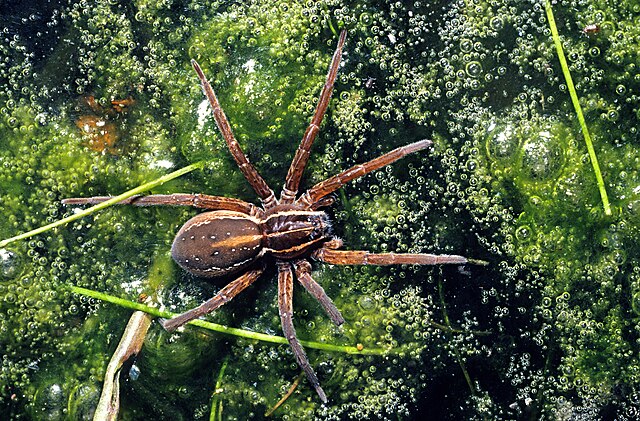
A water spider
Fish-eating spiders use vision only as a secondary sense. In fact, most are nocturnal hunters, sensing the vibrations of their prey rather than seeing them.
By hunting at night, they keep themselves safe from the birds and snakes, which would be their most dangerous predators. Young spiders are vulnerable to attack by dragonflies, and when they’re in or on the water, larger fish such as trout may also prey on them.
They are also prey for a parasitic wasp that paralyzes the spider with its stinger, before laying an egg inside its body.
Where Are Fish Eating Spiders Found?
There are around 100 species of Dolomedes which are the most common family of fish-eating spiders and they are present all over the globe.
The majority are found in Asia, with the greatest diversity in South-East Asia. The second greatest number of species a found in sub-Saharan Africa.
Nine Dolomedes species are found in the US and Canada, but only four types of fish-eating spiders are known to exist in South America.
Spiders That Eat Fish
1. Banded Fishing Spider

Scientific name: Dolomedes vittatus.
Common name: Banded Fishing Spider.
The Banded Fishing Spider is found across the US, predominantly in cypress swamps. It may be grey or brown with whitish stripes over the body and legs. Its diet consists of aquatic insects, tadpoles, and small fish.
The body of a female is around 23mm long, slightly bigger than the male which is typically around 18 mm.
They float on the surface of the water, stretching their legs out in every direction to sense the vibrations of any passing prey. Larger Banded Fishing Spiders can catch and eat small fish.
2. Dark Fishing Spider

Scientific name: Dolomedes tenebrosus.
Common name: Dark Fishing Spider.
The Dark-Fishing Spider could also be classified as a tree-dweller, as it chooses wooded areas to nest and during the day it hides in crevices. It is often found inside houses
However, most do live near bodies of water and feed on aquatic insects as well as small fish.
The body of females is 15–26mm long, while males are 7–13 mm long. However, their legs can range anywhere between 50–90 mm.
This spider can be identified by its light to dark brown color with several distinctive chevron markings and paler stripes around its legs.
Adult female Dolomedes Tenebrosus have a scary reputation as they will strike out fearlessly rather than escaping when threatened. In reality, only one bite has ever been recorded – with effects resembling a bee or wasp sting.
3. Six-spotted Fishing Spider

Scientific name: Dolomedes triton.
Common name: Six-spotted fishing spider, dock spider.
Dolomedes Triton typically lives in ponds and small lakes. Its diet mainly consists of water striders (aka pond skaters), but as an opportunistic hunter, it will eat anything that it can capture, including insect larvae, tadpoles, and small fish.
This spider also has a fascinating technique –it paddles its front legs on the water’s surface to interest and lures fish. Once the fish approaches, the spider dives under the water to capture it.
The body of a female D.Triton is around 15-20mm long, and up to 60mm long including her outstretched legs. The body of a male is 9–13 mm long
4. White-banded Fishing Spider

Scientific name: Dolomedes albineus.
Common name: White-banded fishing spider.
Females measure around 23 mm long and males are around 18 mm.
This spider builds webs but they’re not used to trap prey. It hunts near or in streams and ponds. Its water-repellent hairs allow it to walk on water to chase its prey. By trapping an air bubble on its abdomen, it’s also able to swim and dive, hunting tadpoles, invertebrates, and even small fish.
It is non-aggressive to humans, but if provoked to bite, due to its relatively large size, this can be painful – though not medically significant.
5. Striped Fishing Spider
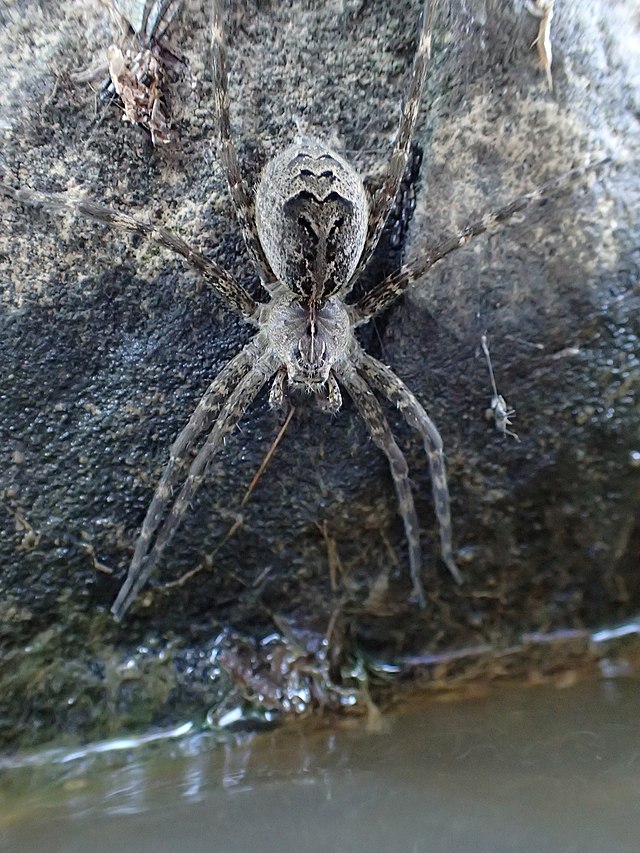
Scientific name: Dolomedes scriptus.
Common name: Striped fishing spider.
This spider gets its name from the “W” shaped marking on its abdomen, which resembles writing. Females can achieve a size of 6cm with their legs extended. It is usually is a light brown color with pale stripes around its legs and a broad stripe along each side of its body.
Like other fishing spiders, it hunts and eats aquatic insects, tadpoles, and small fish.
6. Marine Spider
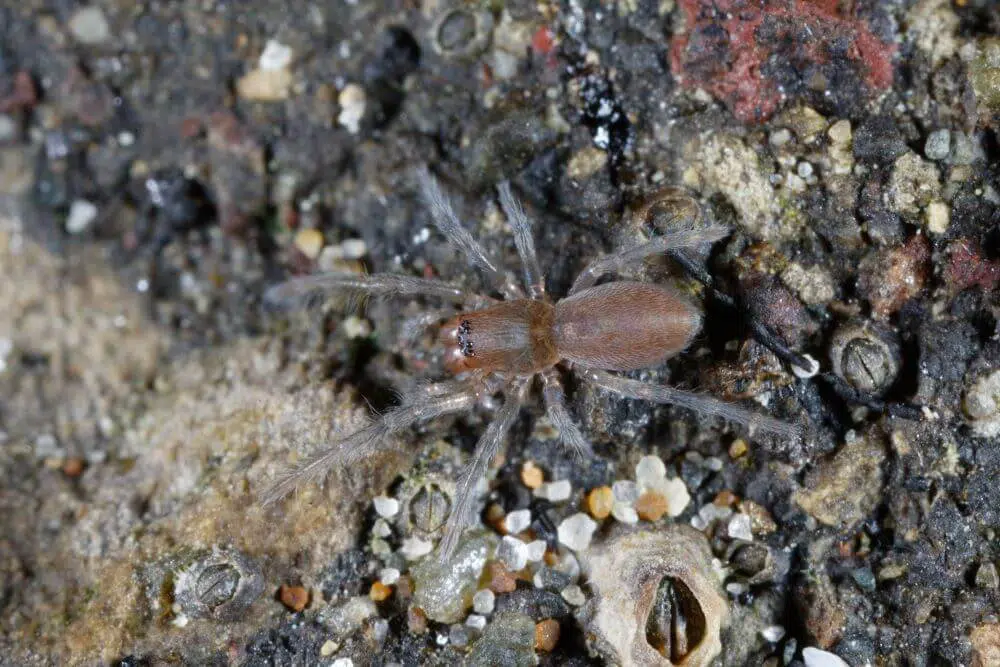
Scientific name: Desis marina.
Common name: Marine spider.
Desis marina is one of several inter-tidal spiders. These live at the seashore, below the high tide line, so for part of each day, they are totally submerged in saltwater.
As they don’t have any particular physical features to help them cope with this, their survival has presented an interesting problem for scientists.
In lab experiments, they’ve been shown to survive as long as 24 hours in seawater. It’s thought that the air bubble captured by their hairs acts like a fish’s gill and provides them with the oxygen they need.
Also, they trap air inside their silk nests, which they construct in shells, sand burrows made by tubeworms, or where kelp clings to the rocks. These have airtight lids, so water can’t get in and air can’t escape. This is enough for them to survive until the tide goes out and they can emerge again. It’s even claimed that they can survive for up to 20 days without needing to leave their nest.
At low tide, they eat small creatures such as shrimps and other crustaceans.
7. Dolomedes okefinokensis

Also known as the Giant Florida Fishing Spider, these are thought to be the largest known species of the Dolomedes genus. Adult female bodies can reach up to 30mm in length.
They’re often found in boggy woodland areas, living near the base of trees.
Incredibly fast but not aggressive to humans, they feed on insects, tadpoles, and small fish.
8. Clever Fishing Spider

Scientific name: Dolomedes facetus.
Common name: Clever fishing spider.
Commonly known as the Clever Fishing Spider, the medium to large species is native to Australia. It lives in freshwater lakes and ponds near coastal areas.
It can run across the water to bite fish many times its size, injecting venom from its fangs to paralyze and kill its prey, which can then be dragged to a safe place to be eaten.
9. Water Spider

Scientific name: Dolomedes aquaticus.
Common name: Water spider.
Native to New Zealand the D.aquaticus lives on open gravel riverbanks, where it’s able to use the stones as camouflage. It’s typically found living less than 5 meters from the water.
A nocturnal hunter, It waits for its prey in darkness, using its body hair to sense vibrations. Like most fishing spiders, it can run across water, diving below the surface when threatened, or when chasing down its prey. It can also sit on the bottom for extended periods, waiting for any danger to pass.
10. Common White-Flanked WaterSpider

Scientific name: Nilus albocinctus.
Common name: Common white-flanked water spider, fishing spider.
Found everywhere in Asia from India to the Philippines.
This distinctive spider is easy to recognize due to the broad, shiny black band which runs the length of its long, narrow body, flanked by white stripes along its length. In contrast, its long legs are a brownish yellow, and the two front legs, in particular, are thick and strong.
11. Diving Bell Spider
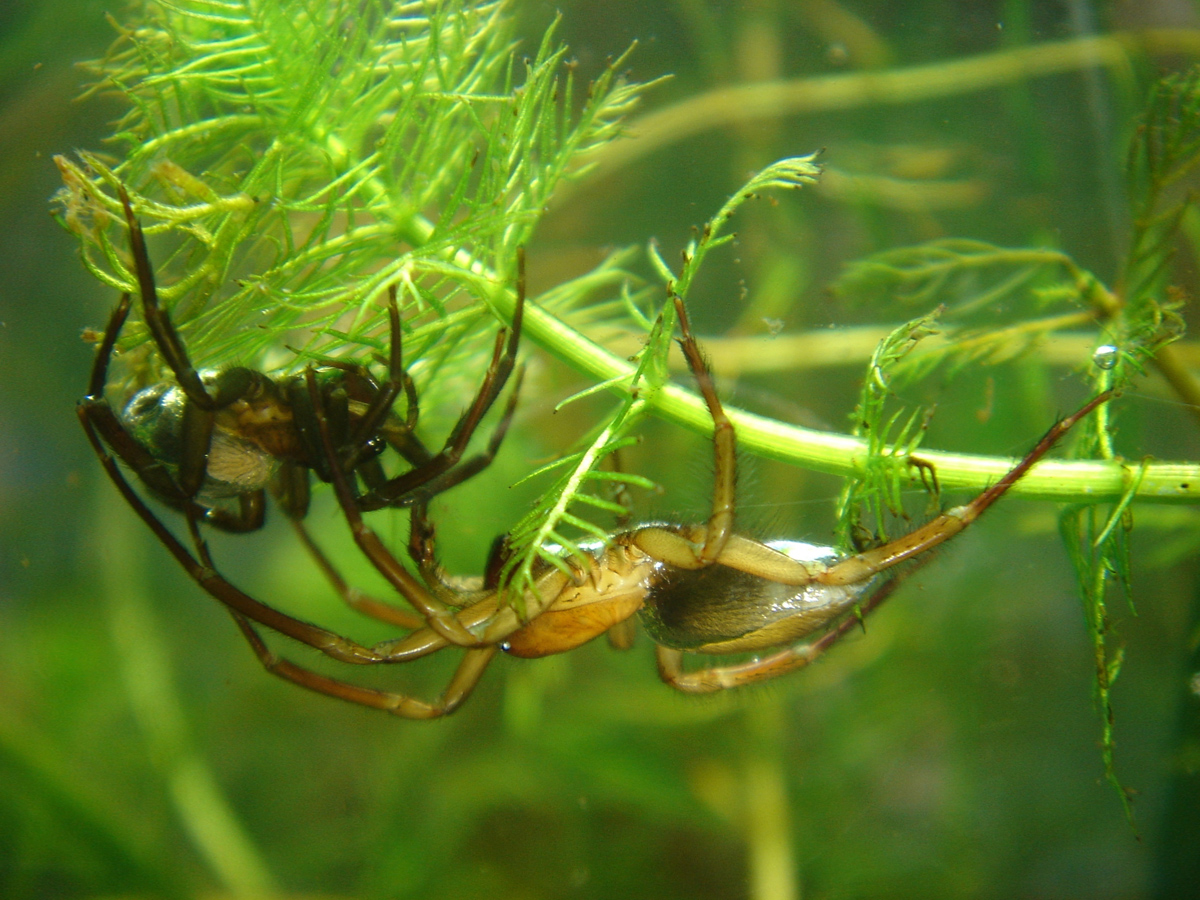
Scientific name: Argyroneta aquatica.
Common name: Diving bell spider, water spider.
Found near clean freshwater lakes, streams, and marshes from Europe to Asia, the Diving Bell Spider or Water Spider is unique as it lives almost entirely beneath the surface of the water.
Its color ranges from mid to dark brown but the hairs which cover its abdomen can make it appear dark-grey and velvety.
It rests, hunts, eats, mates, lays its eggs, and even hibernates underwater. It only comes above water to renew its supply of oxygen or occasionally to bring prey, such as fishes, to the surface.
Males and females both construct diving bell webs where they take their prey to digest them.
The female’s diving bell is larger, as she also uses it for mating and raising young. Females spend most of their lives inside the web, venturing out only to catch prey, or to replenish their oxygen supply. They detect prey when it touches the web or the silk threads they’ve spun to anchor the bell.
Unusually, males are typically 30% bigger than females, at around 10–15 mm long.
12. Fishing Huntsman Spider
Scientific name: Heteropoda natans.
Common name: Fishing huntsman spider.
Found in tropical Asia and Borneo, these spiders are part of the family known as huntsmen spiders.
Fast and skillful predators, they remain motionless until they detect prey within reach. Then, they spring forward and seize their victim with their venomous fangs.
They typically catch and eat insects, but have been observed in laboratories enthusiastically eating tadpoles and fish.
13. Ancylometes rufus

These wandering spiders from Central and South American are considered semi-aquatic as they live close to ponds, rivers, and other freshwater locations.
They can run over the surface of water due to the air-trapping hairs at the end of their legs. These also allow them to remain underwater for more than an hour, using the air which is trapped in the hairs around their so-called ‘book lungs’.
They will eat anything from passing insects to small lizards and, on occasion, small fish.
14. Bandyleg Fisheating Spider

Scientific name: Nilus curtus.
Common name: Bandyleg fisheating spider.
The Nilus Curtus, commonly found in sub-Saharan Africa, is also known as the Thalassius spinosissimus.
Its hunting technique is similar to that of Dolomedes. It anchors itself by one or more legs to an object (such as a log) that is pointing out of the water. It spreads its other legs on the surface of the water.
If disturbed, it crawls down the object and can remain, submerged and out of danger, for up to 35 minutes.
From its vantage point above the water, it senses underwater prey swimming close by, and grabs it with its powerful front legs. It mainly preys on insects but also seizes tadpoles and small fish.
Summary
Fishing spiders, found on every continent, are some of the most fascinating creatures.
Incredibly well-adapted to their habitat these mighty hunters may come in a variety of shapes and sizes, but what they all have in common is their well-earned reputation as some of nature’s most accomplished predators.
Further Reading: